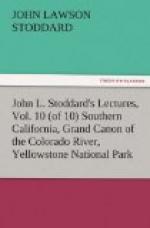[Illustration: A specimen of nature’s handiwork.]
Was Nature ever really sportive? In the old days, when she produced her uncouth monsters of the deep, was she in manner, as in age, a child? Did she then play with her continents, and smile to see them struggle up from the sea only to sink again? Was it caprice that made her wrap her vast dominions in the icy bands of glaciers, or pour upon them lava torrents, and frequently convulse them with a mighty earthquake? If so, New Mexico and Arizona must have been her favorite playgrounds. At many points her rock formations look like whimsical imitations of man’s handicraft, or specimens of the colossal vegetation of an earlier age. Some are gigantic, while others bear a ludicrous resemblance to misshapen dwarfs, suggesting, as they stand like pygmies round their mightier brethren, a group of mediaeval jesters in a court of kings. In the faint dusk of evening, as one flits by them in the moving train, their weird, uncanny forms appear to writhe in pain, and he is tempted to regard them as the material shapes of tortured souls.
[Illustration: A mesa.]
The mesas of New Mexico and Arizona are, usually, regular in outline, sometimes resembling in the distance cloud-banks on the edge of the horizon, but oftener suggesting mighty fortresses, or ramparts to resist invasion, like the wall of China. These are not only beautiful in form and color, but from the fact that they recall the works of man, we gaze at them with wonder, and find in them a fascinating interest. They prove that Nature needs some human association to appeal strongly to us, and how man’s history of smiles and tears gives pathos, mystery, and romance to scenes which otherwise would be merely coldly beautiful or terribly sublime. It is for this reason, doubtless, that we are always endeavoring to personify Nature. We think of solitary trees as lonely, of storm-tossed waves as angry, and of a group of mountains as members of one family. Thus some of the Arizona mountains are called brothers. No doubt their birth was attended by the same throes of Mother Earth, and they possess certain family resemblances in their level summits, huge square shoulders, and the deep furrows in their rugged cheeks; while all of them evince the same disdain for decoration, scorning alike the soft rich robes of verdure and the rough storm-coats of the pines.




